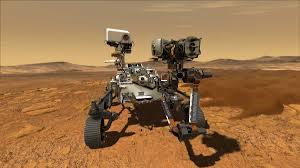On February 18th, The Mars 2020 Mission is scheduled to plunge into the atmosphere of Mars and attempt a landing on the Jerezo Crater. The mission consists of the Perseverance Rover as well as the Mars helicopter, Ingenuity, and will be the third spacecraft arriving at Mars this month. This spacecraft is only the latest iteration in NASA’s long-running Mars program, currently represented on the planet’s surface by the InSight lander, the Mars Science Laboratory, and several orbiters, all constructed for the purpose of exploring the planet and its resources.
Although Venus is actually the planet that comes in closest proximity to Earth, Mars has been explored many more times than any other planet in the Solar System. This is partially due to the fact that it is simply easier to accommodate a craft for the conditions on Mars, as the planet is the most similar to Earth. Mars also has a thinner atmosphere which allows spacecrafts to land with relative ease. However, beyond the appeal of the low difficulty factor, Mars has a rich geologic history to explore, which makes it a compelling planet to study in its own right. In fact, exploration of Mars has shown a great amount of evidence of water, which makes it possible that the planet might once have contained extraterrestrial life.
“We know that there is ice on the surface,” stated Emily Rice, Associate Professor of Astrophysics at the Macaulay Honors College.
“[And while] we don’t know how much water-ice there is on the surface currently, there is a lot of evidence for past liquid water on the surface.”
As liquid water would indicate the potential for life, NASA’s current approach to studying the surface of Mars is known as “following the water”. In this process, NASA rovers attempt to land in an area hypothesized to have contained water, and study the geology of the region in hopes of finding evidence of life. Perseverance is the most recent and thereby most advanced rover built to study this question.
“The mission goal is to collect samples,” Vishnu Sridhar, Intrument Engineer for SuperCAM on the Perseverance Rover, told The Knight News.
“But we want to collect samples that are meaningful for us, and that is why Perseverance is equipped with a number of instruments that work together to identify biosignatures in the rocks and sample them.”
This is a crucial upgrade from earlier rovers such as Curiosity which only performed in situ observations of findings on Mars. However, Perseverance will also be collecting samples for the purpose of returning them for further study on Earth.
Arguably an even more significant difference between Curiosity and Perseverance is that the latter is not travelling alone. Under the belly of the rover is a small helicopter called Ingenuity which will take the first powered flight on another planet. Ingenuity is mainly serving as a technological demonstrator for the feasibility of extra-terrestrial flight, most likely attached to a Mars mission due to the relative ease of getting to the red planet.
That is not to say a Mars mission isn’t without risk. According to NASA, about 50% of Mars missions end up failing. This statistic includes some of NASA’s most infamous miscues, most notably the Mars Surveyor 98’ program consisting of the Mars Climate Orbiter which burned up in the Martian atmosphere due to incorrect conversions between imperial and metric units, and the Mars Polar Lander, whose engines apparently shut off prematurely while the spacecraft was still 40 meters above the surface. Despite this, those working on the current mission are confident that it will be successful and are looking forward to the discoveries and future explorations that will no doubt follow this one.
So what lies in the future of Mars exploration by the United States? In the relatively near future, we have the Mars Sample Return Mission scheduled, in which Perseverance or other rovers will return samples of their findings on Mars back to the Earth for analysis with equipment that simply cannot be sent to Mars. This sample return might finally allow for a definite answer to the exciting question of whether there has ever been life on the surface of Mars. Beyond that of course, lies the exhilarating potential for manned exploration of the Red Planet, which both Sridhar and Rice believe to be the wave of the future. Until then though, here’s to a successful landing on the 18th by Perseverance, and with any luck, many years of incredible discoveries about Earth’s mysterious neighbor, the planet Mars.











